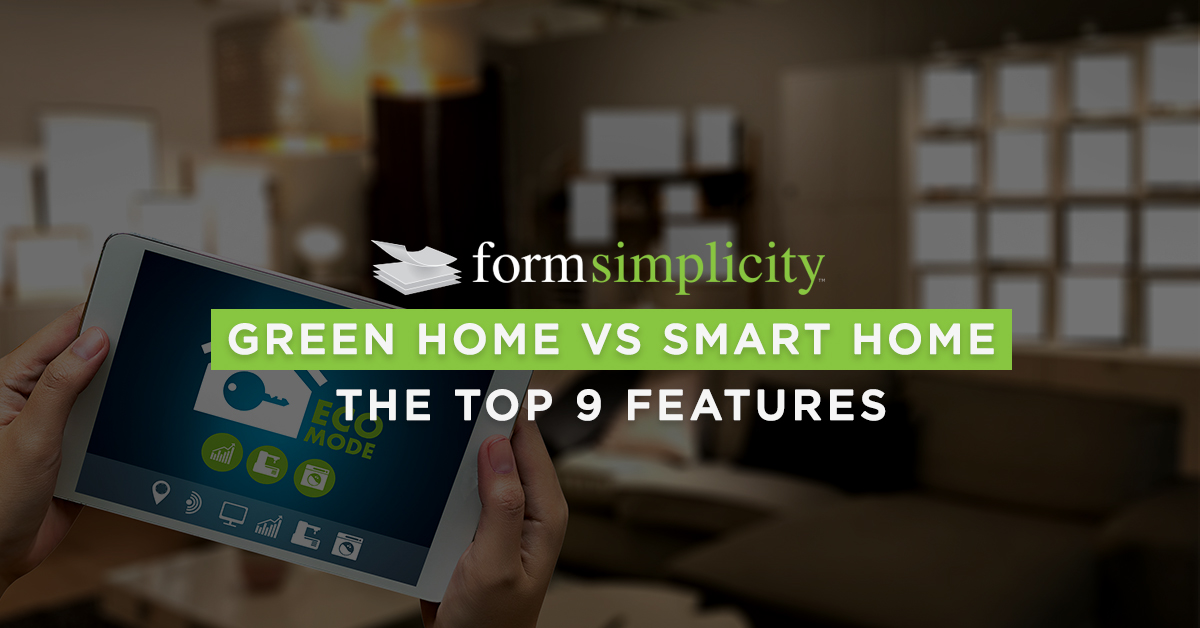
Smart Homes and Green Homes are growing in demand in many parts of the country. Yet, when people think of a Smart Home, some may think it is the same as a Green Home. Yes, they work beautifully together, but they are actually different. This article will highlight each and show you the key features that buyers are looking for now.
What is A Green Home?
A Green Home is built with efficiency in mind, to reduce the footprint it leaves on the natural environment and to support the health of its occupants. The focus is on material selection, energy efficiency, such as wind, water, and solar, and a healthy indoor environment.
The term Green Home is also used interchangeably with Sustainable Home. However, sustainability is a much more encompassing term, as it considers how the home will affect not only the present, but also the future well-being of both the environment and its inhabitants.
According to the Environmental Protection Agency or EPA, Sustainability is defined as a national policy “to create and maintain conditions under which humans and nature can exist in productive harmony, that permit fulfilling the social, economic and other requirements of present and future generations.”
It’s not enough that the home uses natural materials. Harmony between people and the environment now and in the future is the essence of Sustainable Homes.
What is A Smart Home?
A Smart Home is technology-driven and focuses on the convenient operation of the home. Smart Homes are “equipped with network-connected products”. To be considered a “Smart Home”, a property must have these specific features: a reliable internet connection, a smart security feature, or a smart thermostat, and a couple more so-called ‘smart features.’
The network connectivity allows users to open or close the window shades, turn on the tv, or put on your favorite music, with a swipe of their mobile device.
While some features can save energy, such as Heating/Cooling or Lighting features, the focus is on the convenience of using this technology in the home. For example, if, while away from home, you start worrying about whether you left the garage door open, or wonder ,“What do I have in my refrigerator for dinner tonight”? With the touch of your phone or ipad the information is available.
The future is here now. Both Green & Sustainable and Smart Homes are growing in demand for todays’ buyers.
Top Features in Green Home Design
Materials Transparency
Many building codes do not regulate performance of materials and toxicity levels. But whenever you buy a product, you can request a Material Safety Data Sheet. From the outside of the home to the flooring inside, look for sustainable materials such as wood or linoleum (which has a lifespan of 40 years and is recyclable). Bamboo is also a green choice as well as cork flooring.
- No VOC Paint- The Healthy Choice.
Are your clients sensitive to chemicals and artificial fragrances? Use paint inside the home that has no VOC’s (Volatile Organic Compounds.) You can buy no VOC paint for use on the walls and doors inside a home. No VOC paint is the paint that is used in most hospitals. It is available by all the major manufacturers in a wide range of colors.
- Forestry Stewardship Council
For those interested in using responsibly-sourced wood products in construction, look for the label FSC certified. Forestry Stewardship Council is the leading certification “ensures that products come from responsibly managed forests that provide environmental, social and economic benefits” for products coming out of forests throughout the world to certify that whatever is cut or torn down is replanted.
This makes renewal a continual process. It is a highly recognized and respected organization.
As an example, consider bamboo flooring. Bamboo was touted as one of the best natural floorings to purchase since bamboo grows quickly. It is a self-generating grass. But is it Green and Sustainable? Not if it comes on ships from distant countries, which require a lot of fuel to transport it here. And not if deforestation is taking place to meet the demand.
Solar Paneling
Solar power helps homeowners take advantage of natural light to maximize energy efficiency for the home. How the home is positioned on the lot, and where the panels face the sun, can make a significant impact on the solar power that is collected. Check out this cool resource that evaluates the solar potential of your property. (Google’s Project Sunroof website).
When positioned effectively on the roof, solar power can generate enough energy to start selling back unused energy to the utility company.
Every state has different utility incentive programs. There are also grants and tax breaks that may be available when adding solar to the home.
Energy Star Appliances
Energy Star appliances can help reduce monthly energy consumption by up to 40% over standard appliances.
One of my neighbors bought a new energy star refrigerator and saw her monthly electric bill drop by 50%. Her old refrigerator was up and running for over 15 years, yet was using a lot of power. The price of the new appliance paid for itself within a year.
Water Saving Choices
Equipment such as low-flow shower heads, washer machines, dishwashers, and faucets or low-flush toilets can significantly reduce your monthly energy costs. Check with your local utility office whether rebates are available when you purchase low-flush toilets. Many states offer these incentives. If your state does not offer an incentive, check out if a national incentive is available.
Energy Star Windows
Having windows that are well insulated so the cool air from your A/C does not leak out in the summer and the hot air does not leak out in the winter makes for a kind utility bill. Windows that are government-rated as Energy Star products, are much more energy-efficient windows than many of the newer, double-pane models. Using Energy Star windows can also reduce sound transfer between the outside and inside. The benefits are in the substantial decrease of your monthly utility bill.
Top Features in Smart Home Design
Climate Control
One of the favorite home tools to hit the market has been thermostat control through your smartphone. Several companies are offering this automation. One manufacturer, for example, can learn a homeowner’s daily routine and adjust the temperature of the home automatically. Coming home a bit earlier than normal or expecting company for dinner? You can also adjust the temperature wherever you are with your cellphone. Smart features like climate control, when used correctly, lower your monthly energy bills.
Entertainment and Smart Bulbs
Using smart devices, homeowners can control sound and music with their voice or an app. Today, you can stay in one place in your home and make a voice request for the coffee maker to turn on, the tv to turn to your favorite channel, or music to begin playing. Through one or more parts of your home, music can also be amplified with some smart bulbs. Lighting and entertainment in one place.
Home Security
Security systems can be managed and accessed through intercom systems and surveillance cameras can be available on any smart TV or touchscreen in the house. In addition, the security offered through your home or smartphone acts like a highly intelligent monitoring system. Many people who travel or who have second homes like the convenience and peace of mind the smart security system offers them.
Smart Appliances
Retailers are offering Smart Appliances for all areas of the home. From washers to ceiling fans, coffee makers to vacuums, even to power outlets that allow conventional appliances to turn Smart.
- Refrigerators Let You See What’s Inside
Some refrigerators allow you to see what’s inside the glass panel without opening the door, saving energy and keeping items cool. Some allow you to see what’s inside the fridge by showing you photos on an app. Some allow you to link grocery apps to the fridge, so you can easily build your list. This can save time while at the grocery store and shopping for new or replacement items.
Get Smart and Sustainable!
We are on the verge of a new frontier of technological sophistication with the touch of our phones. The most innovative homes are no longer ones that are available only to the wealthy and famous. Smart and sustainable homes are among the top choices of today’s buyers. With these features, your home will be comfortable, healthy, state of the art, and will grow in value as demand for these features continues to rise.
Written for real estate transaction management software Form Simplicity by Janice Zaltman, a Realtor, LEED AP, Marketing Coach and Writer with more than 20 years of experience in the sales, marketing, and media fields.




